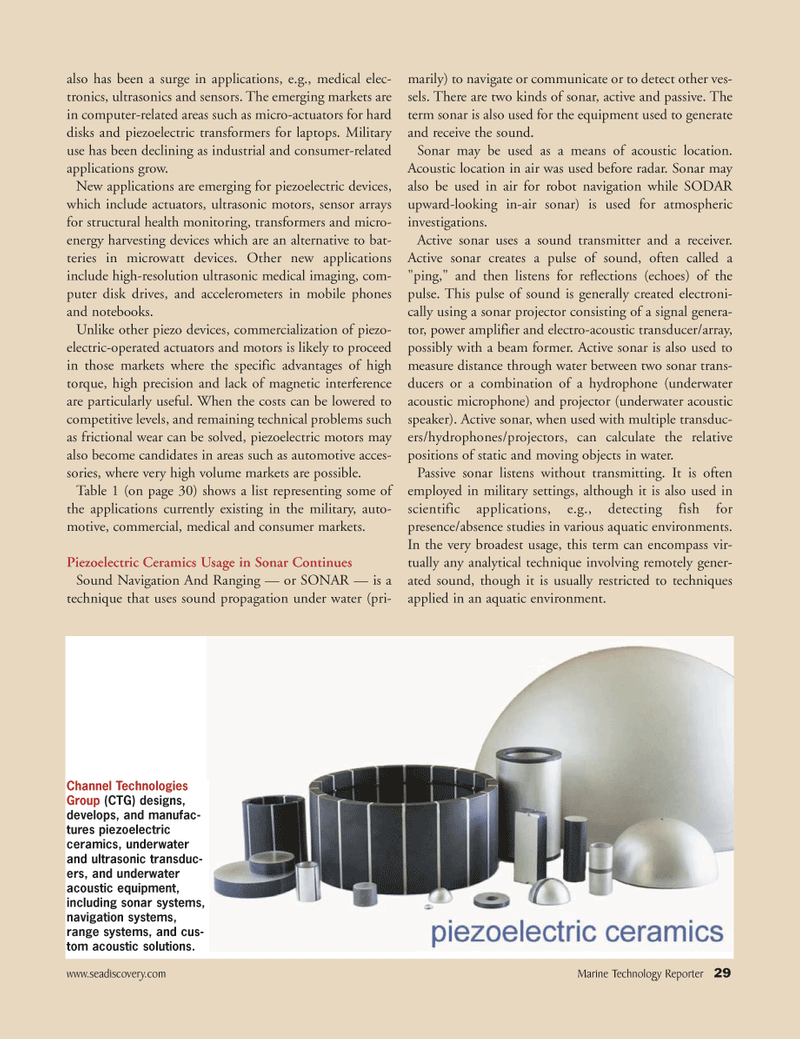
Page 29: of Marine Technology Magazine (May 2011)
Subsea Defense Edition
Read this page in Pdf, Flash or Html5 edition of May 2011 Marine Technology Magazine
www.seadiscovery.com Marine Technology Reporter 29 also has been a surge in applications, e.g., medical elec- tronics, ultrasonics and sensors. The emerging markets are in computer-related areas such as micro-actuators for hard disks and piezoelectric transformers for laptops. Military use has been declining as industrial and consumer-related applications grow.
New applications are emerging for piezoelectric devices, which include actuators, ultrasonic motors, sensor arrays for structural health monitoring, transformers and micro- energy harvesting devices which are an alternative to bat- teries in microwatt devices. Other new applications include high-resolution ultrasonic medical imaging, com- puter disk drives, and accelerometers in mobile phones and notebooks.
Unlike other piezo devices, commercialization of piezo- electric-operated actuators and motors is likely to proceed in those markets where the specific advantages of high torque, high precision and lack of magnetic interference are particularly useful. When the costs can be lowered to competitive levels, and remaining technical problems such as frictional wear can be solved, piezoelectric motors may also become candidates in areas such as automotive acces- sories, where very high volume markets are possible.
Table 1 (on page 30) shows a list representing some of the applications currently existing in the military, auto- motive, commercial, medical and consumer markets.
Piezoelectric Ceramics Usage in Sonar Continues
Sound Navigation And Ranging — or SONAR — is a technique that uses sound propagation under water (pri- marily) to navigate or communicate or to detect other ves- sels. There are two kinds of sonar, active and passive. The term sonar is also used for the equipment used to generate and receive the sound.
Sonar may be used as a means of acoustic location.
Acoustic location in air was used before radar. Sonar may also be used in air for robot navigation while SODAR upward-looking in-air sonar) is used for atmospheric investigations.
Active sonar uses a sound transmitter and a receiver.
Active sonar creates a pulse of sound, often called a "ping," and then listens for reflections (echoes) of the pulse. This pulse of sound is generally created electroni- cally using a sonar projector consisting of a signal genera- tor, power amplifier and electro-acoustic transducer/array, possibly with a beam former. Active sonar is also used to measure distance through water between two sonar trans- ducers or a combination of a hydrophone (underwater acoustic microphone) and projector (underwater acoustic speaker). Active sonar, when used with multiple transduc- ers/hydrophones/projectors, can calculate the relative positions of static and moving objects in water.
Passive sonar listens without transmitting. It is often employed in military settings, although it is also used in scientific applications, e.g., detecting fish for presence/absence studies in various aquatic environments.
In the very broadest usage, this term can encompass vir- tually any analytical technique involving remotely gener- ated sound, though it is usually restricted to techniques applied in an aquatic environment.
Channel Technologies
Group (CTG) designs, develops, and manufac- tures piezoelectric ceramics, underwater and ultrasonic transduc- ers, and underwater acoustic equipment, including sonar systems, navigation systems, range systems, and cus- tom acoustic solutions.

 28
28

 30
30
